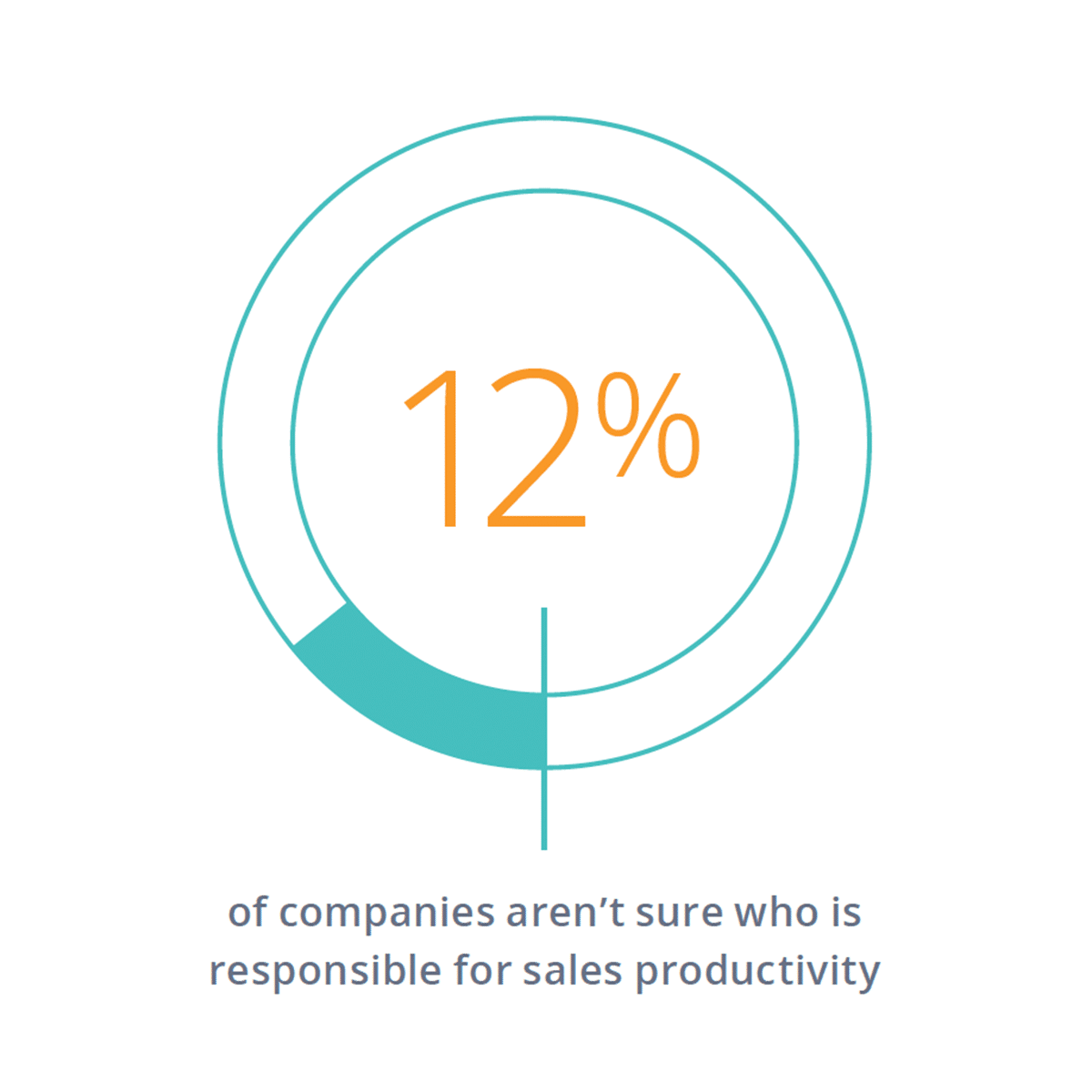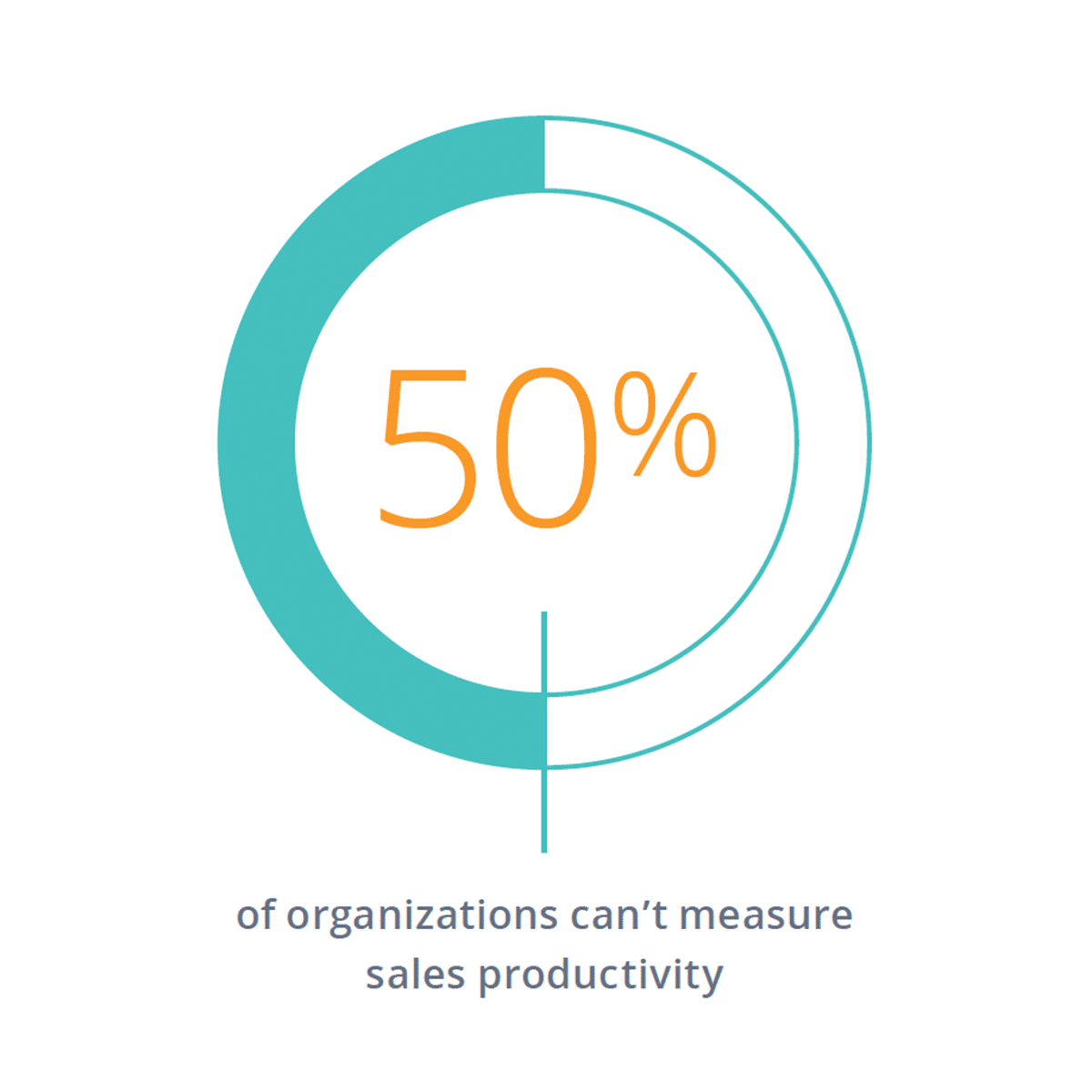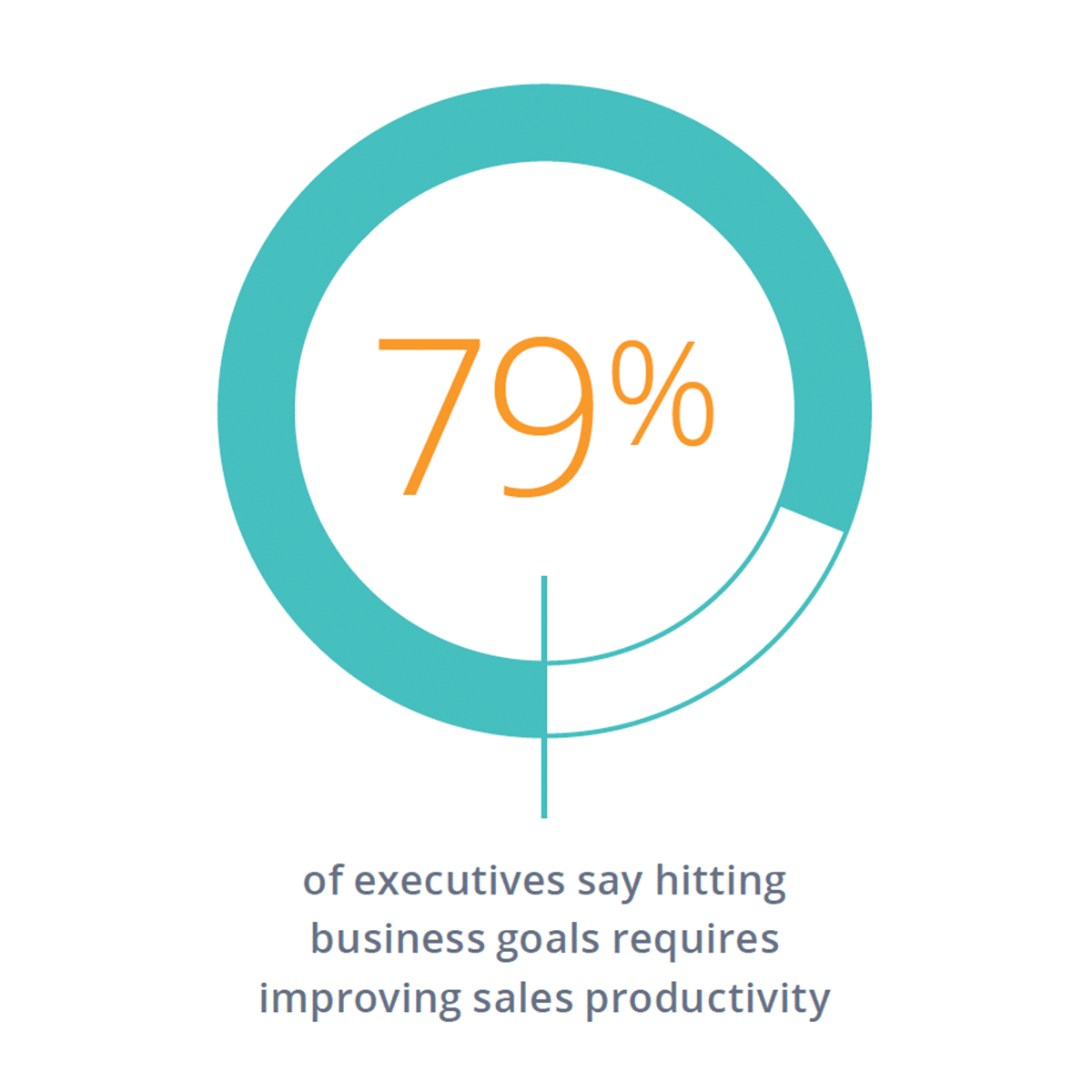Have you ever calculated how much time you — or your team — spends actively selling each day? Chances are it’s less than three hours.
In fact, up to two-thirds of a sales person’s time each day can be spent on non-revenue-generating tasks such as navigating internal processes, filing paperwork, building reports, and more. With so much on your plate, you can’t simply allocate more time to sales-specific activities to boost your revenue.
To meet your goals, you have to find a way to be more productive instead.



Source: Salesforce
When it comes to maximizing time and minimizing resources to improve your sales process productivity, it can be hard to know where to start. In fact, almost half of all organizations have no way to measure sales productivity and as many as 12% of companies aren’t even sure who is responsible for it.
Yet, 79% of executives from that same survey say that hitting their company’s goals — such as closing more deals and improving their bottom line — requires improving the productivity of their existing sales team.
According to the most basic definition of sales productivity, there are two ingredients to getting more done: increase your efficiency and increase your effectiveness. That means spending more time on high-impact activities, less on low-impact activities, and maximizing the use of your resources to accomplish your goals.

But if you’re already putting all of your effort and much of your time into hitting your quotas, working harder simply isn’t a reasonable option and it’s certainly not a very motivating one. So let’s explore tips, tricks, and tools even the busiest sales reps can use to maximize their time at each step in the sales process.
Using some of these recommendations will allow you to close more deals with less work.
Prospecting: Start Your Sales Process Off Strong
Prospecting is a critical first step to every sales process. A curated list of potential customers makes hitting your quotas much more attainable.
Whether you’re sourcing leads from events, networking groups, referrals, purchased lists, or any number of alternatives, being able to prospect quickly and effectively is a necessary skill for a productive salesperson. Plus, a solid prospecting strategy sets you up for success down the road.
How can you improve?
According to HubSpot, up to 50% of Sales’ time can be wasted gathering leads. Sales teams are pressed for time, so what can you do to prospect better leads more efficiently without adding more work to your day?
The first thing we recommend is putting manual prospecting in the back seat for a bit and investing in an automated approach — check out the tools below. It could also be advantageous to implement or upgrade your customer relationship management (CRM) system. Doing so will help you create new customer records, and save time keeping track of their status in the sales process.
What’s the best way to measure productivity?
We know leads are valuable, the question is how do we get more of them for our business? It’s a great question. Knowing the number of leads you’re prospecting is a good way to begin to understand how productive your process is.
PROSPECTING METRICS
LEADING IN
# of new contacts found# of new contacts added
LOOKING BACK
# of prospects that turn into customers
Knowing how well your sales process is working takes a deeper understanding. Get to know your ideal customer, your expected outcomes, and the length of time it takes to convert them.
You can get a rough measure of success by calculating how many of your prospected leads turn into customers. If the number is lower than you expect, you may need to consider adjusting your prospecting process or requirements.
Tools for success
Here are our recommended tools for maximizing your sales prospecting process:
- To automate your lead sourcing, try a list building tool such as:
- Using a well built, customizable CRM platform will keep your data clean and consistent. Take a look at:
TIP: Make sure it integrates with your list building tool.
Connecting: Master the First Touch in Your Sales Process
Mastering the first touch can be difficult. Once you have a prospect on the phone you have less than a minute to make an impression.
Getting it right takes practice and patience, but cold calls and outreach emails are both highly effective methods for getting a meeting with a decision-maker — especially when used together.
How can you improve?
There are a number of ways to level-up your cold calling skills, but the first thing we recommend doing is preparing for the individual types of connections you plan to make.
To do this, you will need a good understanding of your ideal customer, the challenges they are facing, and how your solutions help solve them. Ask yourself:
- What do I know about this prospect’s business?
- What might their goals and objectives be?
- Is there anything unique about this industry?
Personalize your communications by referencing a problem your prospect might be experiencing, this will help you make a connection early and get your relationship off to a good start.
TIP: When discussing your solutions, provide value at this stage — do not sell.
Before jumping into your outreach, write out what you will say or send, then review it to make sure it comes across as human. Try adding personalizations such as “I hope you had a good weekend” or “I see you are offering a new service.”
What’s the best way to measure productivity?
Understanding how your outreach is working will help you plan the best way to spend your time.
For example, know the number of prospects who are answering your communications, know how many phone calls you have to make before you get an answer. This will help you determine how effective your email/call cadence is.
CONNECTING METRICS
LEADING IN
# of calls made/answered# of emails sent/opened
# of touches before a connection
# of scheduled appointments
LOOKING BACK
# of kept appointments
Even with the right outreach, many variables can influence your productivity. Connecting with the right people, at the right time, on the right platform can make or break your sale. Run iterative experiments to get to the bottom of these questions and adjust your process according to what you find out.
You can optimize your productivity by automating parts of your process such as sending introductory emails and scheduling appointments to save additional time.
Tools for success
Here are our recommended tools for automating your connections with prospects:
- Implement a CRM such as HubSpot or Close listed above. Many have capabilities that allow you to automate your outreach, contact life-cycle, and lead status scoring.
- Try a stand-alone sales engagement platform with content management capabilities, guided selling, and analytics to make it easier to deliver value to your prospects without a CRM.We recommend SalesLoft. or Outreach.
- Eliminate the back-and-forth availability conversations with an automated appointment scheduling tool such as Calendly and Setmore.
- Perfect your research and get to know your candidate’s personality faster with AI tools such as Crystal, an app that analyzes your prospect’s online profiles and delivers information to help you better communicate.
- Further automate your outreach with productivity tools such as TextExpander, which help you save time on repetitive typing tasks with form-like templated snippets of text you can expand with simple commands.
Qualifying & Preparing: Get to Know Your Sales Prospects
This stage of the sales process is where all of your prospecting and outreach pays off. Remember those leads you connected with earlier? This is the get-to-know-you/get-to-know-your-problems phase and probably the best point in your process to ensure your productivity.
How can you improve?
Once a prospect has been added to your lead capture system, automate the qualification process by setting up a lead scoring system. These systems assess how your leads have responded to your outreach and how much time they spend looking at your solutions. It then assigns them a lead score, which you can use to focus your research.
For example, to make the most of your lead qualification and preparation, take the highest-scoring leads from your database and dig in with a more manual approach to better understand:
- The problem(s) they are trying to solve
- If they are evaluating other solutions
- Their role in the decision-making process
- If they have a budget
Answer these questions with a sales qualification framework — BANT is a traditional option, while GPCT is a good option for well-informed prospects.
The information you gain from this process will help you better tailor your sales pitch and final ask. Add all these relevant details into your contact’s record so it is readily accessible when it’s time to close a deal.
TIP: Ask open-ended questions instead of simple yes/no questions to gain more information and have a more engaging, back-and-forth conversation.
What’s the best way to measure productivity?
It can be hard to know when to stop gathering intel on your hottest prospects. How much information is too much, really? To keep yourself from continuing down an unproductive rabbit hole, remember to focus.
These metrics can help you determine whether you should spend more time preparing or if you should call it quits.
QUALIFICATIONS AND PREPERATION METRICSLEADING IN
Time spent researchingLead response time
LOOKING BACK
Time spent on a call
To maximize your time, aim to send more precise emails and try batching the time you spend researching and on the phone. Don’t forget to share what you learn about prospects with your larger team by recording it in your CRM.
Tools for success
Here are our recommended tools for storing what you know about your leads:
- CRMs can provide the functionality you need to quickly collect, store, and find information about each of your prospects. Systems such as HubSpot and Salesforce are built for this and integrate well with other lead management tools for easy lead transfer.
- Systems designed specifically for lead scoring such as VanillaSoft, which are great for making and documenting a high-volume of calls.
- Databases such as G Suite or Microsoft 365 are an easily-accessible way to store contact data if you aren’t using a CRM or another lead scoring tool.
- Tools such as Zoominfo and Apollo can help you fill in the gaps of an incomplete database. For example, if you have a name and company the software might be able to pull in the company’s annual revenue.
Presenting: Put Your Lead Research to Work
Your sales product demonstration should do one thing: communicate your solution’s benefits by focusing on its value to your prospect. This approach helps you build credibility and establish the trust you need to move your prospect through the final stages of your sales funnel toward a purchase.
How can you improve?
Put all your research to work and create a message that gets right to the heart of your prospect’s problems. The more you can demonstrate your familiarity with their challenges, the better you can direct them to your solution.
If you want to be a great salesperson, rehearse what you will say. Know your product’s features and benefits by heart. Nothing says “this solution isn’t quite right for you” like a sales representative that hesitates before answering a question.
TIP: Your talk doesn’t have to be a long one. Remember, the magic part of the sale process involves listening not responding.
What’s the best way to measure productivity?
There is no universal trick to getting your sales prospect to convert faster, but there are a few ways to determine if what you are doing is working the way it should.
First, are you booking meetings with all of the right people? If so, are they prepared to make a decision?
Ensuring you are getting in front of the decision-makers and that they are ready to take the next step is essential. It’s always frustrating when you get to the end of a pitch and your prospect says “I can’t make a decision right now because…”
SALES PRESENTATION METRICS
LEADING IN
# of booked meetings
LOOKING BACK
Types of questions asked
Opportunity win rate
Tools for success
Here are our recommended tools for creating and delivering home-run sales presentations:
You can save time creating presentations with the AI, templates, and features in these non-traditional sales presentation tools:
Create specialized graphics and videos with these online editors:
For graphics:
For video creation:
For conferencing and online meetings:
Closing & Objection Handling: Finish the Sale with Confidence
When it’s time for your prospect to make a decision, how can you ensure they choose you and do so in a timely manner?
Work on your approach. There are a number of closing techniques you can use. The one you choose will depend heavily on your particular circumstances. But there is one thing they have in common: Initiating the close is key.
How can you improve?
Ask yourself this: Are your prospects saying no?
Handling objections is probably the most time-consuming part of closing a deal. If the price, timing, or feature package aren’t just right, it can take some time to settle on the final terms of your contract.
Your response when you get handed an objection is essential to moving forward quickly, so make sure you are able to articulate your value well. It can also be helpful to focus on the next step, instead of reselling the product. Help your prospects see what life will be like after they’ve made a purchase.
What’s the best way to measure productivity?
The journey to get to close can feel long. Looking back on the process, there are probably many things you feel you could have handled differently.
However, your true measure of success comes down to measuring metrics such as the volume of closed deals over a specific period. Digging into other metrics—such as lost opportunities—can tell you where you might need adjustments in your sales approach. Once you understand this, you can create a sales process that maximizes your productivity.
CLOSING METRICS
LEADING IN
Time spent selling# of proposals sent
LOOKING BACK
# of closed deals# of lost opportunities
Tools for success
- Eliminate some of the time it takes to create contracts and proposals and collaborate during negotiations with one of these tools.
- Automate document signing to save yourself a lot of hassle at the end of a sales cycle. Try one of these tools for delivering contracts and collecting signatures:
- Create templated blocks of text for frequently used information—such as your company’s boilerplate, proposal language, and agreement terms—in tools such as TextExpander, can standardize and simplify repetitive workflows.
Following-Up: Improve Your Sales Process
Following up with all of your opportunities — both lost and won — to make sure you’ve delivered on your promise is essential. Nothing ruins your reputation faster than an unhappy customer or a lost opportunity that leaves with a sour experience.
Plus, you can use this final-stage connection as an opportunity to introduce cross-sells, upsells, and address any remaining pain points that exist with your customer — a great way to increase your bottom line.
How can you improve?
Take it one step further than seeking out your contact’s opinions and encouraging repeat business. Ask open-ended questions and let your contact do most of the talking.
It’s also a great idea to take this connection point as an opportunity to tap into their network. Get referrals, ask for recommendations. Securing testimonials or asking happy customer to share their experience on social media will help you to refuel your sales pipeline with quality leads.
What is the best way to measure productivity?
Setting a reminder task in your CRM is a great way to remember to conduct these interviews. But how do you make sure you get the most out of them?
When reaching out, treat it like another sales opportunity. Make sure you have a hook that makes it worth their time. Also, give your customer a heads up that you’ll be reaching out at a later time to see how they are doing.
FOLLOW-UP METRICS
LEADING IN
Sales cycle lengthAnnual contract value
Customer acquisition costs
LOOKING BACK
Customer lifetime valueSatisfaction ratings
Retention rates
Tools for success
Here are our recommended tools for effortless sales follow-up:
- Set up a personalized questionnaire in SurveyMonkey that you send to your contacts before you get in touch.
- Create a library of questions you copy into your follow-ups as they make sense. Tools such as TextExpander make this simple.
Take advantage of any automated solutions in your CRM. Many have functions created specifically for making follow-up stress-free, such as tasks or triggers.
Keep it simple
Statistics show that the highest-performing teams use a lot more technology than their counterparts — sometimes up to three times as much.
Make sure yours works together and communicates efficiently. If you can, choose a single platform — such as a robust CRM system — that touches all aspects of your sales process.
If that’s not possible, we recommend tools such as Zapier to help your productivity-boosting technologies communicate with each other.
Whatever you do, keep it simple for yourself. The last thing you want to do is spend all the time you save managing your technologies. To be sure you’re always functioning at your best, make sure you are dedicating time in your sales process to maximizing your tech for better productivity and getting people through your sales funnel faster.

